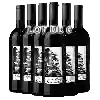
Château l'HesperitLa Dame Blanche Montravel Sec
This wine generally goes well with
Details and technical informations about Château l'Hesperit's La Dame Blanche Montravel Sec.
Discover the grape variety: Perlaut
A cross between Cinsaut and Csaba pearl obtained in 1956, registered in the Official Catalogue of Table Grape Varieties, list A1.
Informations about the Château l'Hesperit
The Château l'Hesperit is one of of the world's greatest estates. It offers 7 wines for sale in the of Guyenne to come and discover on site or to buy online.
The wine region of Guyenne
45 kilometres east of Bordeaux, Blasimon is perched on a hillside overlooking the Gamage, a tributary of the Dordogne. Its hilly sites and its calm make it an ideal place to relax. A Village of medieval origin, its origin reflects the traditional organization of the bastides. The city conceals one of the Romanesque jewels of the Gironde, the Benedictine abbey of the X-XIII th centuries.
The wine region of South West
The South-West is a large territorial area of France, comprising the administrative regions of Aquitaine, Limousin and Midi-Pyrénées. However, as far as the French wine area is concerned, the South-West region is a little less clear-cut, as it excludes Bordeaux - a wine region so productive that it is de facto an area in its own right. The wines of the South West have a Long and eventful history. The local rivers play a key role, as they were the main trade routes to bring wines from traditional regions such as Cahors, Bergerac, Buzet and Gaillac to their markets.
The word of the wine: BSA
Brut sans année, is said of non-vintage champagnes. It is the technical name of the first price champagne made from wines of different years. They are most often called Tradition, Carte blanche, Réserve. To be drunk quickly, rather as an aperitif.














